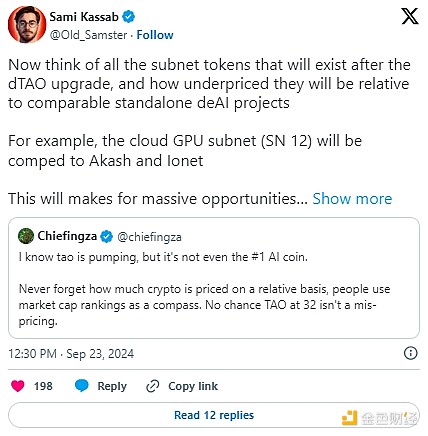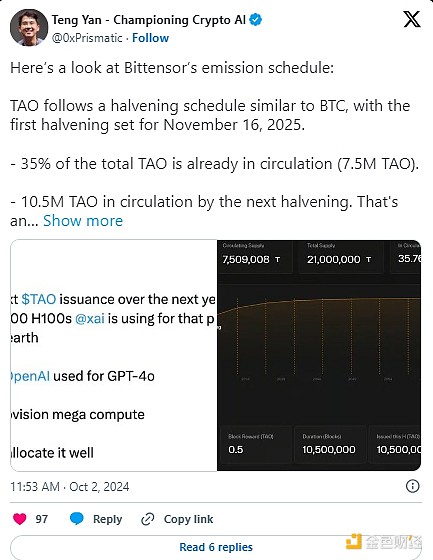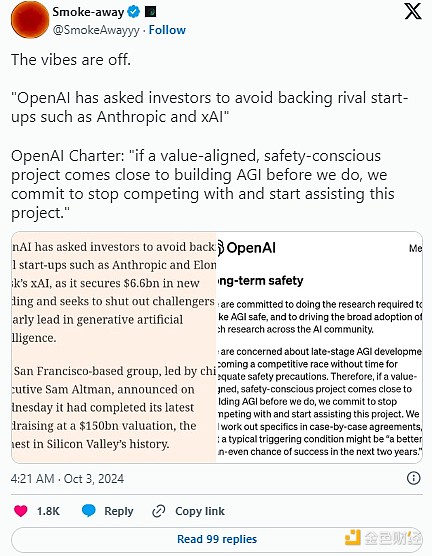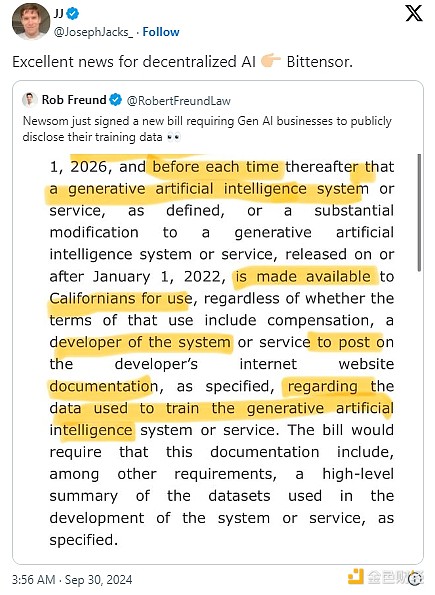Author: Jun, Bankless; Compiler: Baishui, Golden Finance
Bittensor (TAO) has captured the attention of investors, and it’s easy to understand why. The narrative around AI is both simple and powerful, and in the current crypto cycle, few categories are hotter than AI x crypto. As one of the most prominent projects in the space, Bittensor has positioned itself as one to watch.
In essence, Bittensor is pushing a new frontier: creating a decentralized network where AI models can be trained and shared in a way that is incentivized for both developers and users.
This combination of a clear narrative and real technical substance has captured the imagination of the market. But there’s more to this story than just hype. Behind the recent price surge are significant developments in the TAO ecosystem itself, as well as widespread enthusiasm for AI.
In this article, we’ll explore what’s happening in the Bittensor ecosystem and examine upcoming catalysts that could drive its momentum.
Expansion of Subnets
A major catalyst behind Bittensor’s growth has been the rapid expansion of subnets.Introduced a year ago, subnets have quickly become the backbone of Bittensor’s development. Today, Bittensor has over 50 active subnets on mainnet, with many others on testnet that will come online in the near future. The proliferation of subnets accelerates the functionality of the network, attracting more developers, users, and attention.
Understanding the importance of this, the Opentensor team (a major contributor to the Bittensor ecosystem) has steadily increased the subnet limit over time — from 32 initially, to 45, and now to 52. The gradual increase in the cap reflects both the growth in network capacity and the need for more subnets to come online.
As the subnet limit is gradually expanded — and eventually removed entirely — the potential for exponential growth within the Bittensor ecosystem becomes clear. More subnets means more AI models, more collaboration, and more growth for the ecosystem.
Dynamic TAO: Turning Bittensor into an Investor’s Playground
One of the most anticipated upgrades in Bittensor’s history is the dynamic TAO, or dTAO. Now live on the RAONET testnet, the dTAO will introduce a dynamic marketplace for subnets.
With the dTAO, each subnet will soon have its own token, allowing its value to be determined by market forces. This fundamentally changes how subnets operate and how participants interact with the network. Subnet tokens will create a competitive landscape where the most efficient and valuable subnets thrive, while less efficient ones fade away.
In addition, this introduces a new speculative dynamic to the Bittensor ecosystem. TAO holders will now be betting on individual subnets as well as the network as a whole. For investors, this opens up new opportunities - they will be able to screen subnets, analyzing their performance, utility, and long-term potential. Just like cryptocurrency traders search Coinmarketcap for undervalued gems, the dTAO will create a similar dynamic within the Bittensor ecosystem.
Critically, all this activity increases demand for the TAO itself. Since the TAO is required to acquire any subnet tokens, the introduction of the dTAO is likely to further stimulate demand for it, making Bittensor even more attractive to investors.

TAO will halve in 2025
Bittensor is about to have its first halving event, which is expected to occur at the end of 2025. Much like Bitcoin's halving cycle, this event will cut the issuance rate of new TAO tokens in half.
Currently, the Bittensor network issues 1 TAO in the form of block rewards (7,200 TAO per day), which are distributed to miners, validators, subnet owners, and delegators. However, when the halving occurs (triggered when 10.5 million TAO are in circulation), this issuance will be halved to 0.5 TAO per block, reducing the supply of new TAO entering the market each day.
Why does this matter? When the supply of TAO decreases, it creates scarcity. In any market, a decreasing supply coupled with steady or rising demand (thanks to the addition of subnets and the introduction of dTAOs) can only lead in one direction: up.
What makes this event particularly bullish is the psychology behind the halving cycle. Investors often anticipate these events months in advance, leading to speculative buying as market participants prepare for the impending supply shock. Bitcoin’s halving events have always triggered price surges, and TAO’s first halving will likely generate similar excitement within the Bittensor community and beyond.

Bittensor’s Unparalleled Attention
Bittensor continues to capture the attention of the crypto and AI communities. From a busy side event at Token2049 in Singapore to a popular talk at Google, it’s clear that Bittensor maintains a consistent level of attention in the space.
The project’s rabid following on Twitter keeps the conversation lively, pushing Tau further afield. Asset managers like Grayscale and Arca have publicly shared their bullish outlook, further legitimizing Bittensor in the eyes of institutional investors.
Now let’s look at the macro-level things happening in the AI world that are considered bullish for AI x crypto projects like Bittensor.
The Problem with OpenAI
OpenAI is at a crossroads. Recently it was announced that OpenAI is transitioning from a non-profit to a for-profit benefit corporation. Following this restructuring, the company’s valuation surged to over $150 billion and raised $6.6 billion in new funding.
Additionally, the recent departure of several key executives, including CTO Mira Murati and two other executives, has raised concerns about potential internal issues.
This shift has sounded alarm bells in the AI safety community, prompting many to question whether OpenAI can truly be committed to responsible AI development when profit comes first.

Against this backdrop, the promise of open-source, decentralized platforms like Bittensor becomes clear. While OpenAI charts the path to enterprise, Bittensor represents a vision of a fairer AI future that thrives on community-driven efforts.
Regulatory uncertainty for centralized AI
Centralized AI has hit roadblocks everywhere. As governments scramble to regulate, the restrictions they impose could stifle innovation. Across jurisdictions, AI is already under scrutiny. Europe is rolling out its AI Act, which mandates adherence to strict standards, while China has set rules to align AI with national policy. In the United States, regulators are padding around, calling for more oversight and control; however, in a recent incident, California Governor Gavin Newsom vetoed a major AI safety bill that would have imposed strict regulations on AI models. Many viewed the veto as positive, as it avoided heavy-handed regulation that could have hampered innovation and driven AI companies out of California.
Nevertheless, AI regulation remains very tight in jurisdictions around the world. The fact that centralized AI is subject to regulatory control highlights a fundamental flaw: it’s too easy to control.
When a few large companies hold the keys to centralized AI, they become prime targets for government pressure and censorship. This is exactly where decentralized AI platforms like Bittensor have the advantage. They can’t be shut down or censored by any single entity because no single entity controls it.

Conclusion
Bittensor has a lot of things going right, and the rise in token price is just the icing on the cake. With existing momentum, the aforementioned upcoming updates, potential EVM support, and continued community development (such as the rapid integration of NousResearch’s breakthrough in distributed training into Bittensor), these are strong indicators of Bittensor’s prospects.
In a world where centralized AI is increasingly subject to regulation, scrutiny, and profit motives, Bittensor offers a compelling alternative: a decentralized, community-driven approach built on collaboration, innovation, and shared incentives. Here’s why it’s worth watching.
 Weiliang
Weiliang








